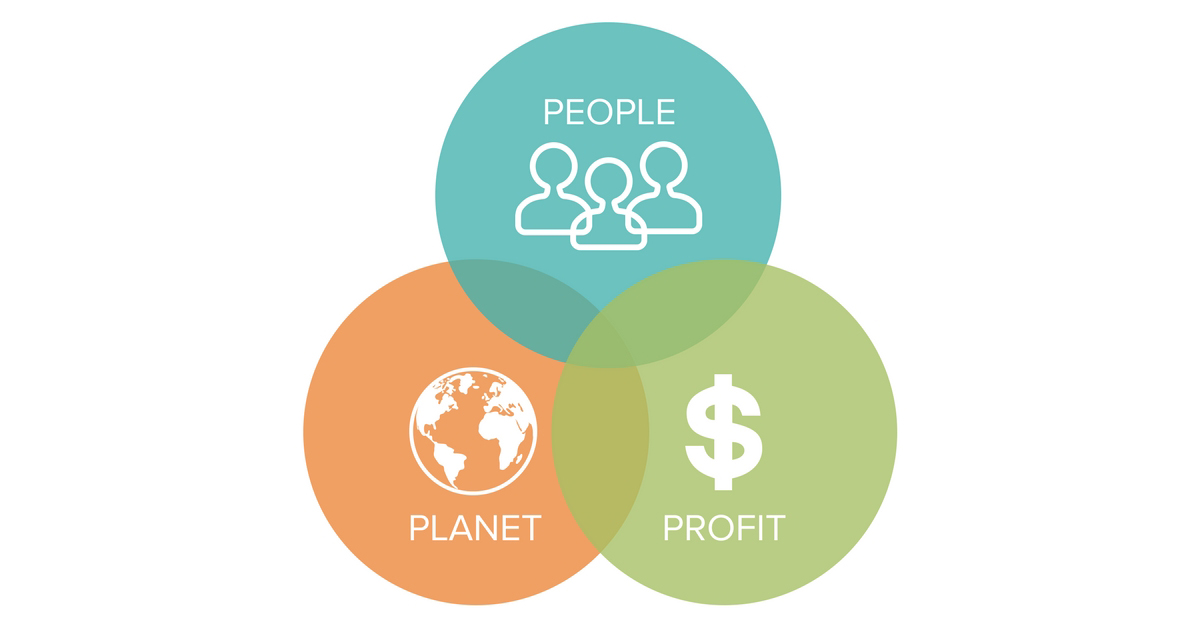
More and more, companies are making a commitment to sustainability and social responsibility, alongside increased profits. In fact, diligence with the first two can have significant influence with consumers. How entities prioritize and measure the performance of all three is known as a triple bottom line accounting framework. Ultimately, entities want sustainability and social solutions that benefit the triple bottom line—solutions that deliver value to people (customers, employees, and stockholders,) the planet (wise resource use,) while also increasing profits.
As of 2017, 85% of S&P 500 companies are reporting corporate sustainability results. Their efforts have effected thousands of smaller entities that are part of the supply chain. And because of this, most companies are now paying some attention to energy use, resource waste, and other sustainability issues.
Sustainability encompasses a lot, it includes resource use and preservation, as well as issues related to human rights, gender equity, and more. As a company begins to set its priorities, internal teams needs to assess current practices, benchmark results, and determine where they can make the biggest impacts.
And as entities prioritize issues and identify strategies for achieving them, we encourage them to pay special attention to engaging their employee in these efforts. Including employee engagement in triple bottom line strategies can deliver benefits in ways you might not anticipate.
Triple Bottom Line: The People
It should be obvious that engaging employees has immediate benefits for your stakeholders. A Johnson Controls study showed that 96% of potential employees preferred to work for a company that was environmentally aware—we all want to feel good about the work that we do and the company we work for. And increasingly, employees want to be part of the solution. One study estimates that 88% of millennials want to help their employers achieve social and environmental goals. We recommend engaging employees and informing them of the company’s progress on environmental goals. We also suggest giving them opportunities to help achieve corporate objectives, enabling employees to be part of the solution. Involvement makes employees feel good about their efforts and yours, which contributes to overall well-being and morale.
Employee engagement also correlates to higher customer satisfaction, showing that sustainability benefits for people extend beyond staff to also include your customers. And of course that’ll make your stockholders happy too, because employee engagement also correlates to higher profitability.
Triple Bottom Line: The Planet
Recognizing the risks of climate change, companies are adopting increasingly aggressive, science-based sustainability goals. And these are stretch goals to be sure. Whereas it was relatively easy for entities to achieve a 1-2% reduction in energy usage a decade ago, as companies become more efficient and goals become more aggressive, achieving savings is harder and harder. Aggressive goals require culture change, not just a sustainability strategy tacked on to the existing culture. And culture is about everyone—companies need all employees moving in the same direction, identifying and eliminating waste.
Here are a couple of examples to help to illustrate this point: A service company might focus first on its building energy usage, perhaps installing high tech controls to ensure that the lights and cooling system are off when the building is unoccupied. Some of these buildings also integrate renewable energy systems. We’ve seen great innovations in this space with entities striving for carbon neutral buildings. As buildings get more efficient, the activities of building occupants become more critical. For example, one study estimated that 55% of the energy usage in high performance buildings is plug load—the computers and printers in cubicles, the coffee makers, refrigerators, and smartphones being charged around the facility. Addressing plug load, of course, requires broad employee engagement because everyone’s making choices that either increase or decrease plug load in the building.
Similarly, businesses with any kind of fleet operations are plagued by idling costs. Idling vehicles is akin to burning money—and, worse, often you’re burning the money in front of your customers. We see lots of companies installing monitoring equipment to mitigate idling. But ultimately, changing fleet idling habits is about culture change. It’s about engaging employees and inspiring new habits.
Perhaps most importantly, employees are your best source for new ideas on ways to reduce waste in your operations. In every organization there are employees who have great ideas for cutting costs. You just need to engage these employees, so that they are inspired to share those ideas!
Triple Bottom Line: The Profits
At its core, the triple bottom line is a recognition that when you do what’s right for people and reduce waste in your operations, your profits will increase.
As noted above, employee engagement correlates with profitability. The latest Gallup meta-analysis suggests that companies with highly engaged employees are 21% more profitable than their peers with low engagement.
Employee engagement also reduces employee turnover, which means lower HR expenses, less lost productivity, and more profitability.
And of course, reduced waste—consuming less energy and water, producing less landfill waste—all of that reduces expenses too.
As you think about your company’s triple bottom line, we encourage you to think about the central role employee engagement can play in enhancing your efforts.
Please contact us if you’d like to learn more about how Cool Choices can help you inspire employees to help you increase benefits to people, the planet, and profits.
Comments are closed.




